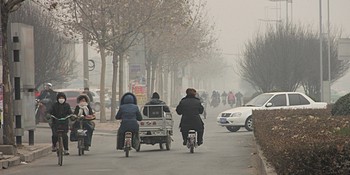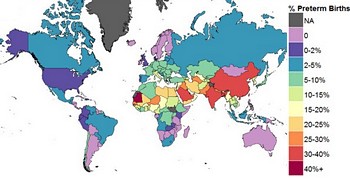Results suggest that addressing major sources of fine particulate matter (PM2.5) – from diesel vehicles, to agricultural waste-burning, could save babies’ lives and improve health outcomes.

When a baby is born preterm (at less than 37 weeks of gestation), there is an increased risk of death or long-term physical and neurological disabilities. In 2010, an estimated 14.9 million births were preterm – about 4–5% of the total in some European countries, but up to 15–18% in some African and South Asian countries. The human and economic costs are enormous.
There are many risk factors for preterm birth – from the mother’s age, to illness, to poverty and other social factors. Recent research has suggested that exposure to air pollution could also be a risk factor. A new study published in the journal Environment International for the first time quantifies the global impact by combining data about air pollution in different countries with knowledge about how exposure to different levels of air pollution is associated with preterm birth rates.
It finds that in 2010, about 2.7 million preterm births globally – or 18% of all pre-term births – were associated with outdoor exposure to fine particulate matter (PM2.5 is especially harmful to human health, as it can penetrate deep inside the lungs).
“This study highlights that air pollution may not just harm people who are breathing the air directly – it may also seriously affect a baby in its mother’s womb,” said Chris Malley, a researcher in SEI’s York Centre, at the University of York, and lead author of the study. “Preterm births associated with this exposure not only contribute to infant mortality, but can have life-long health effects in survivors.”
Malley noted that while many other health impacts of air pollution have been documented – most notably through the Global Burden of Disease studies – the focus has been mainly on premature deaths from heart disease, respiratory problems, etc. “This study adds an important new consideration in measuring the health burden of air pollution and the benefits of mitigation measures,” he said.

A pregnant woman’s exposure can vary greatly depending on where she lives – in a city in China or India, for instance, she might inhale more than ten times as much pollution as she would in rural England or France. The study did not quantify the risk in specific locations, but rather used the average ambient PM2.5 level in each country, and analysed the results by region.
The largest contribution to global PM2.5-associated preterm births was from South Asia and East Asia, which together contributed about 75% of the global total. India alone accounted for about 1 million of the 2.7 million global estimate, and China for about another 500,000. Western sub-Saharan Africa and the North Africa/Middle East region also had particularly high numbers, with exposures in these regions having a large contribution from desert dust.
“There is uncertainty in these estimates because the concentration-response function we used is based mainly on studies in the United States and Europe,” Malley said. “Not only don’t we know whether the relationship is the same at much higher concentrations, such as those found in some Indian or Chinese cities, but the prevalence of other risk factors also varies considerably. Expectant mothers in many places are also exposed to high levels of indoor pollution from cooking smoke. Resolving these uncertainties will require more studies in these countries and regions.”

The analysis grew out of SEI’s Initiative on Low Emission Development Pathways (LED-P), which includes the development of a “benefits calculator” to help policy-makers and planners assess the potential benefits of undertaking measures that reduce air pollution.
This work in LED-P is contributing to the Climate and Clean Air Coalition to Reduce Short-Lived Climate Pollutants (CCAC), where SEI is working with UNEP and other partners to support more than 20 developing countries in Africa, Asia and Latin America to develop plans to reduce emissions leading to particulate air pollution.
Global modelling and satellite data analysis were conducted by Daven Henze, co-author of the study from University of Colorado, Boulder, through his membership on the NASA Air Quality and Applied Sciences Team (AQAST).
“Our colleagues from countries such as Ghana, Peru, Nigeria and Bangladesh have highlighted the importance of air pollution impacts on health as a motivation for reducing emissions,” said Johan C.I. Kuylenstierna, co-author of the study, SEI’s policy director, and a member of the CCAC Scientific Advisory Panel. “Knowing that reducing outdoor air pollution could help reduce preterm births provides a compelling new reason to invest in mitigation measures.”
So, what could be done to reduce PM2.5 exposure among pregnant women? Given that many mothers, particularly in the poorest and most vulnerable populations, cannot easily relocate, the key is to address the sources of pollution, Malley and Kuylenstierna stressed. PM2.5 particles include a variety of substances, such as black carbon (soot), sulphates, nitrates and ammonium, as well as dust from soil and from industrial processes such as cement production.
“To reduce the PM2.5 problem, you need to control many different sources, but in many developing countries, certain emission sources dominate,” Kuylenstierna said. “This includes emissions from cooking with biomass fuels (which is also associated with very harmful indoor pollution), diesel vehicles and other transport, and particles emitted when agricultural residues are burned in fields. Forest fires also contribute to ‘regional haze’.”
“It is important to realize that action needs to be taken on all the major sources,” Kuylenstierna added. “In a city, maybe only half the pollution comes from sources within the city itself – the rest will be transported there by the wind from other regions or even other countries. That means that often regional cooperation is needed to solve the problem.”
Read the study (external link to open-access journal article)
Learn more about pre-term birth (external link to World Health Organization)
Learn more about outdoor air pollution (external link to World Health Organization)
Mike Ashmore
Design and development by Soapbox.


